The Huawei Mate 9 Review
by Matt Humrick on January 27, 2017 7:00 AM ESTDisplay
The Mate 9 still uses an FHD (1920x1080) IPS LCD like the Mate 8, but this is an entirely new panel with a different backlight assembly and a small reduction in screen size from 6 inches to 5.9 inches. This is more than just a rounding error: The Mate 9’s screen is definitely smaller, although it’s difficult to notice unless the two phones are sitting side by side. Pixel density increases to 373ppi, up from the Mate 8’s 368ppi, but again this is not really noticeable. While most flagship phones are now using QHD (2560x1440) panels, especially for AMOLED, FHD is still adequate for LCD panels up to around 6 inches due to its greater sub-pixel density relative to PenTile AMOLED panels. There is some loss of sharpness at this size, however. With the Mate 9, it’s possible to see a hint of aliasing on curved edges when specifically looking for it, but this is imperceptible during normal use. The Mate 9’s screen is still very sharp.
Even with a high-quality panel, proper calibration is still necessary, something Huawei has struggled with in the past. Its use of wide-gamut panels and unbalanced RGB settings, which lead to an overly cool white point and screens with an obvious blue tint, hurt color accuracy and negatively impact the user experience. To see if the Mate 9 breaks this trend, we’ll use an X-Rite i1Pro 2 spectrophotometer for color measurements and an i1Display Pro colorimeter for luminance measurements.
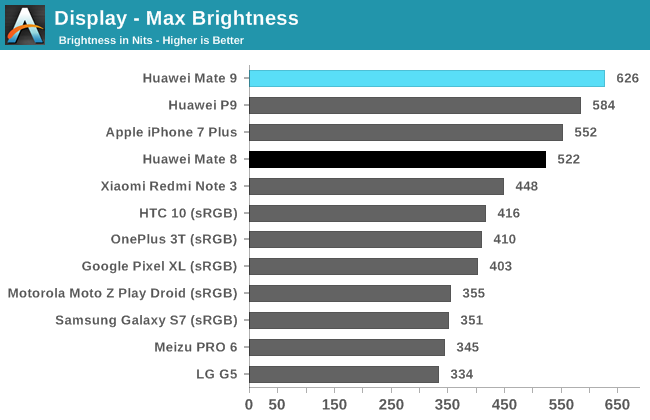
The Mate 9 reaches an impressive 626 nits at peak brightness, about 100 nits more than the Mate 8 and about the same as the iPhone 7 Plus, which hit 618 nits when using its auto-brightness boost (the value in the chart above is for manual mode). It’s even higher than Huawei’s P9 that uses a backlight with 20 LEDs (versus the usual 16 LEDs for a 5-inch class display) to increase peak brightness. And because the Mate 9 does not have an overdrive feature, this peak brightness is available in both manual and auto-brightness modes. Outdoor visibility is quite good, and the display goes down to 4 nits at its lowest setting, making it suitable for use in a dark room.

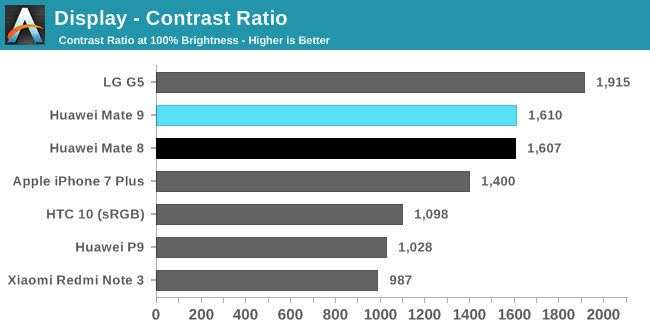
Black level and contrast ratio are measured at maximum brightness, which makes direct black level comparisons more difficult because a display’s black level increases with brightness; however, after normalizing for this effect, the Mate 9’s black level is among the best we’ve tested—equal to the Mate 8 and LG G5, a little better than the iPhone 7 Plus, and noticeably better than the HTC 10. Based on these results, it’s safe to say that the Mate 9’s display uses photo-aligned crystals to improve black level and contrast ratio.
The phones with OLED panels are not shown in these charts because they are able to achieve a black level of zero and a mathematically infinite contrast ratio by being able to completely turn off individual pixels.
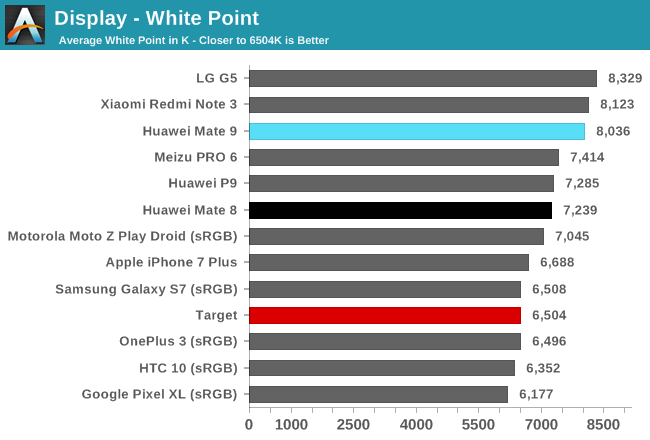
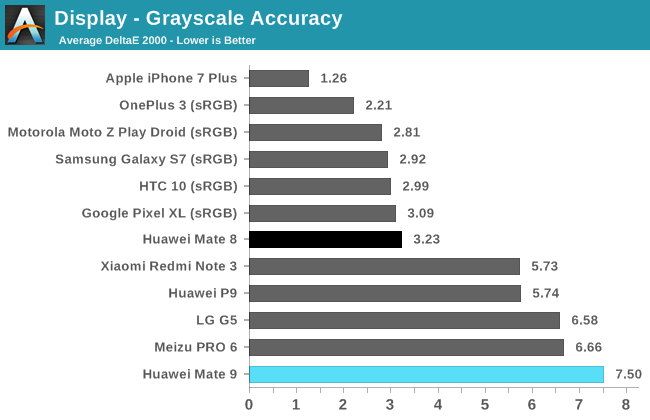
Our grayscale testing shows how Huawei continues to struggle with display calibration. At its “Default” setting, the Mate 9’s white point is over 8,000K, which is even cooler than the Mate 8 and P9. There’s too much emphasis on the blue and green primaries and not enough red, leading to rather poor grayscale accuracy—its ΔE2000 grayscale error is greater than 10 between 75%-100% luminance. This produces a noticeable aqua tint when looking at a white screen.
The Mate 9, like other Huawei phones, offers “Cold” and “Warm” color temperature modes as well as the ability to select a custom white point target by dragging a finger around a color wheel. The Cold setting moves the white point even further from the D65 target value. Increasing the imbalance between blue and red, while reducing the green primary slightly, shifts the hue of the display’s tint from aqua to blue. The name of the Mate 9’s Warm mode is misleading: There’s still too much green and not enough red, giving the screen a mint green tint.
It’s nice that Huawei includes the ability to set a custom white point; however, despite my best efforts, I was unable to get the average CCT to drop below 7,500K or completely correct the RGB imbalance that gives the screen a blue/turquoise/green tint. The best I could do was balance blue and green, while giving a small boost to red, which reduced grayscale error somewhat and made the aqua tint much less noticeable.
Huawei also missed the mark when calibrating the Mate 9’s gamma curve. In general, gamma is a bit too high, leading to a loss of shadow detail and slightly darker images. The gamma curve is not stable over the full luminance sweep either.

Huawei continues to use wide color gamut displays for its flagship phones. The Mate 9’s display extends coverage for reds and greens but the blue primary falls short relative to the sRGB gamut. Android’s lack of color management usually leads to oversaturated colors on wide gamut panels, and the Mate 9 does exhibit this characteristic for most hues once they reach the 50%-60% saturation level; however, the effect is less pronounced at lower saturation levels, where we see greater accuracy. Changing between the different display modes shifts color hues due to changes in white point but does not significantly alter saturation levels. While the Mate 9 does not have an sRGB mode to improve saturation or color accuracy, it manages to have vibrant colors without being overly garish like some wide gamut panels.
To see how the Mate 9 achieves its wider color gamut, I measured the spectral power distribution (SPD) of its backlight with a spectrometer and compared it to the LG G3, which shows the typical signature for a panel that covers around 100% of the sRGB color space. The G3’s sharp peak around 450nm comes from using blue LEDs, while broader, smaller peaks in the green and orange portions of the spectrum are from yellow photoreactive phosphors applied to the LEDs. The wavelengths of light emitted by the backlight combine into what we perceive as white light.
The Mate 9’s SPD shows a sharp peak at 455nm, indicating that it also uses blue LEDs; however, the response in the green and red portions of the spectrum look significantly different. The greater output in these colors, which give the Mate 9 its wider gamut coverage, comes from using red and green phosphors instead of a single yellow phosphor.

Color accuracy in Default mode is better than expected considering the poor grayscale performance and wide gamut display. The Mate 9’s average ΔE2000 error is not great, but most of the tested colors actually fall below 3, the threshold where error is generally considered acceptable. Using the custom setting, whose better RGB balance reduces the error component due to hue shift, drops color error further, with only highly saturated colors showing significant error.
Neither of the two Mate 9’s in our lab show any backlight bleed or issues with luminance uniformity; however, the Mate 9 suffers from the same off-axis viewing issues as the Honor 8. There’s a noticeable white, red-tinted glow that’s plainly visible at angles greater than about 10°-15° that becomes progressively worse at higher angles, eventually washing out blacks completely around 45°. There’s also a series of concentric, rainbow-colored ovals that show up when viewing the screen off-center, which are most visible on a white background, a likely byproduct of stressed birefringence in the cover glass. These rainbows are even more pronounced when viewed through polarized sunglasses. Because you’ll likely be looking at the screen straight on most of the time, these problems are not dealbreakers, but other IPS displays, like those used in the iPhones and other flagships, do not have these issues.
Display performance continues to be an issue with Huawei’s flagship phones. The Mate 9’s display in particular gets very bright and has excellent black levels for an IPS panel. But Huawei’s poor calibration degrades grayscale and color accuracy, and the preconfigured Cold and Warm white point settings only make things worse. Manually setting the white point produces better results, but the Mate 9 still cannot match the accuracy and viewing angles of its peers.


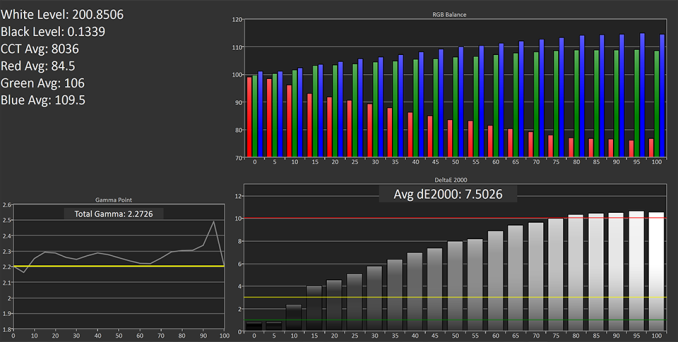

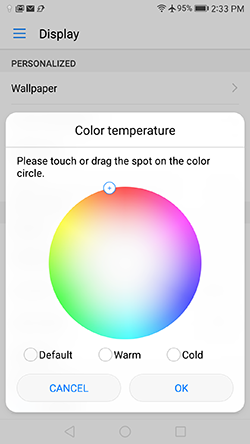

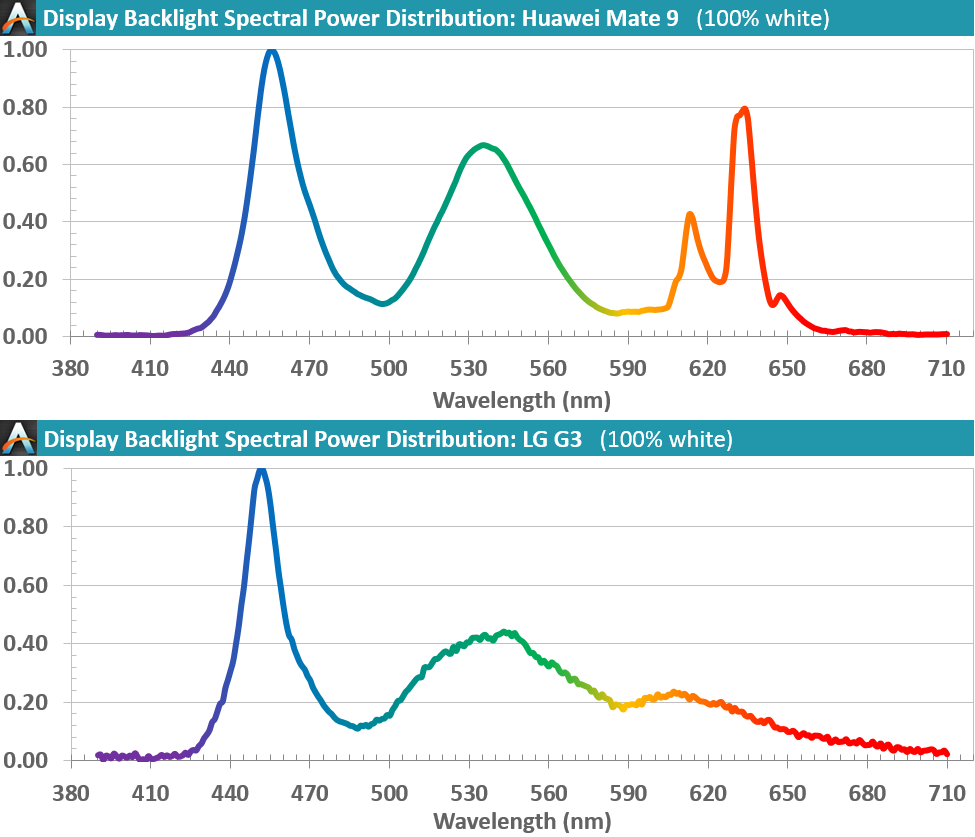










84 Comments
View All Comments
lolipopman - Saturday, January 28, 2017 - link
No mention of thermal throttling, great work, guys!Meteor2 - Saturday, January 28, 2017 - link
?? Read the review more carefully.s.yu - Saturday, January 28, 2017 - link
At least they didn't send the Samsung copycat version over for the review.Shadowmaster625 - Saturday, January 28, 2017 - link
And yet another android SoC gets eaten by apple.cokata1 - Sunday, January 29, 2017 - link
The Mediatek X30 should be a very interesting SoC to take a closer look at. I hope Anandtech does a deep dive for it. 2X A73 @ 2.8Ghz with 4x A53s and 4x A35s all on 10nm process. This should be the first Mediatek SoC that is competitive with the rest when it comes to power/watt, and we will see the A35 for the first time.thek - Sunday, January 29, 2017 - link
Hey look this website isn't dead..UtilityMax - Monday, January 30, 2017 - link
Are you guys also going to review the Huawei Mediapad M3? That was basically the only top-major-vendor brand new Android tablet introduced in the USA in 2016.aryonoco - Monday, January 30, 2017 - link
Anandtech reviews are completely losing sight of what's important.There is a whole section on "Software", where multiple paragraphs are spent talking about what the icons looks like and what this specific highlight color is. And yet there is no mention of stuff that actually matters: What Android security patch level is this thing running? Has the manufacturer committed to providing security updates on a timely basis? For how long?
What's the point of spending $600 on a device that comes with root exploits out of the box?
Now tell me, is prompt security updates not worth even a single mention in a product review?
Matt Humrick - Tuesday, January 31, 2017 - link
I discussed Huawei's update policy in our Honor 8 review, which I linked to in the first paragraph of the software section. As of today, the Mate 9 has the November security patch. Currently, I would say Huawei is about average for releasing security updates and a little below average for releasing OS updates.akdj - Wednesday, February 1, 2017 - link
Matt,I just wanted to drop a quick thanks and throw some shade your way for both a job well done and continued efforts in spite of ridiculous, incessant and from the same family of foolishness ubiquitous throughout technology review and rumor sites, forums and social media.
I'm not alone and I'm sure most here recognize just the recovery time to 'process' sites, sounds - products and future technology gleaned from another CES - which ended just three weeks ago! Not to mention 'Vegas' recovery in and of itself, travel and catch up with, what I'm sure each of you have, that 'other life'! It's obligations, responsibilities and a few hours of sleep --
Not to mention constant communications with different OEMs about product, shipping and scheduling and doing so with the offering of a completely free website run by enthusiasts who possess more knowledge in a broader expanse of tech hard and software than most of us readers and typical but focused enthusiasts interested in other areas and aspects of technology.
IMHO, the job you do for the millions each of you makes yearly;) - is nothing less than greatly appreciated by an exponential percentage that'll ever take the time to post, even register with your site - IOW; you've a huge percentage of 'happy' and 'return' visitors vs. the usually humorous and ignorance displayed by a few in your response and comments. I've long since given up responding to each bozo I disagree with, reserving my attacks for those deserving and spreading unusual, over the top BS about product to perspective users, buyers or legitimate queries
You still host a site second to not a single site when it comes to in depth, well written and researched/combined with real world usage, avoiding time to press pressure... providing amazing, compelling reviews filled with detailed objective and subjective data by authors with obvious enthusiasm for technology and it's constant march in to the future inevitably offering faster, more reliable, durable 'better' product choices every day, week, month, and years that go by...
Some'll still be feeding spiders in mom's basement, drinking Mt Dew with a serious lack of 'outdoor time' - @ 45 years old behind the anonymity of their keyboards waking daily with a single goal in mind. Belittle others, demand from anyone but themselves, and magnify their miserable (yet easily changed, bettered, and enjoyed...) existence online.
As anonymous ghosts empowered by their ability to hide in mom's basement, enjoying a false sense of security while feeding said spider;)
Take care, Happy New Year and hopefully you've had the opportunity to recover from CES, transfer your stills and video and 'thoughts/notes' to the 'mainframe' - with a chance to unwind and debrief! As always, regardless of when the A10 'deep dive' is posted, an in depth essay on the architecture of the new SD-835 or your review of the new MacBook Pro's 15" fully upgraded Touch Bar hits - whether beaten by your ten pages on Dell's XPS 15" - I'll be here, I'll read and guaranteed, I'll enjoy your time, efforts and enthusiasm for a job VERY Well Done
Thanks
Jeremy